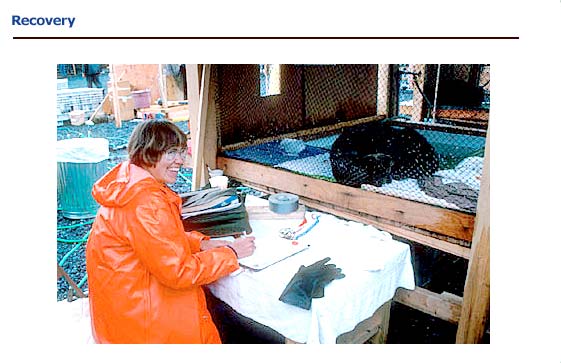After cleaning with detergent, the sea otter’s fur may not immediately regain its water repellent quality, even after conditioning with squalene. This may result from:
(1) incomplete restoration of normal concentrations of squalene in the fur and skin,
(2) absorption of detergent by the keratin in the cuticle and cortex of the hair which makes the surface of the hair hydrophilic (water absorbent) and lowers the effective surface tension, or
(3) mechanical disruption of the underhairs so that they no longer form a tight, interlocking network that traps air.
Normal grooming behavior by the otter and the gradual reintroduction to water usually results in full restoration of the fur in seven to ten days. Allowing the otter to groom in water is essential for full recovery. However, it may become chilled and should be monitored closely by the husbandry staff. If the otter begins to shiver or becomes lethargic, it should be removed from the water immediately and dried with a commercial pet dryer.

Grooming aligns the underhairs so that they trap air and probably stimulates the production of sebum, which may restore the water repellency of the hair cuticle. Otters usually groom their head and chest first, then proceed to their back and abdomen. Grooming behavior includes rubbing the fur with the forepaws and hind flippers, tumbling and rolling in the water, and blowing air into the fur with the nose. Occasionally, otters will groom each other. As the underhairs become interlocked and the air layer is restored, the fur will become noticeably water repellent and will regain its normal appearance. The percentage of the otter’s fur that has regained its normal water repellency should be visually estimated and recorded daily in the husbandry record (Appendix 2, Form J Download PDF). Otters that fail to groom properly because of poor health or aberrant behavior associated with the stress of captivity will not restore their fur to normal. Consequently, they will need veterinary care and a low-stress environment to resume normal grooming behavior in the rehabilitation center.

